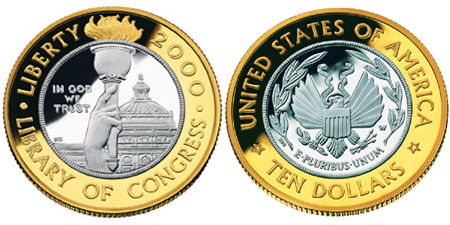Bi-metallic coin
A bimetal or bimetallic coin (also duplex coin) is a coin, consisting of two different, separated from each other metals or alloys. Most of those coins are composed of a circular core of one material and a surrounding ring of the other material.
It should not be confused this term with the bimetallism that identifies the system of currency (mostly silver and gold) is covered by two metals.
Coins, which are made up of several metals, but only occur as a uniform alloy, are not referred to as bi-metallic. Known Bimetal are the 1 - and 2- euro - pieces and the Thai 10 Baht coin that is very similar to the 2- euro coin of appearance and weight.
One reason for making such duplex coins is the higher security against forgery than in the case of normal coins.
Engineering and Manufacturing
In the manufacture first center and ring are made as blanks, then the edge lettering is embossed on the ring edge, then ring and center are wrapped in each other and only in the last step the blank is embossed with the coin image and thus to the coin. As the production of duplex coins is more complex than that of normal coins, it is also more expensive.
Unlike thermobimetals deformation during temperature changes is undesirable in Bimetal. The materials used must therefore have identical or at least similar linear expansion coefficient. This can be achieved by the use of corresponding composite alloys.
For duplex coins of lower quality, it may happen that the center slip or fall out of the ring, this happens especially with large temperature fluctuations. If you were to heat a Euro in hot water, you could also observe this effect, since the metals expand differently. Duplex coins slipped centers achieve - if the errors are conditionally coinage - high collector prices. Lands with a Euro askew center but "just so" but in the wallet he is nothing special, because this effect with simple tools can often pay for.
History
For the first time duplex coins came on in the 1970s. Are known as the Italian 500 lira pieces that were manufactured 1982-2001. Since 2001 duplex coins reached more widespread since the 1 - and 2- euro - pieces are also manufactured in this way. In the 1- Euro - pieces, the ring of golden shiny nickel brass and the center of shining silver copper nickel. In the 2- euro coin, it is the other way around. Also after the duplex principle, for example, the 2 - and 5 - zloty - pieces manufactured in Poland. 2005 Turkey adopted at its 50 Kurus and 1 lira coins, coins duplex.
In the early 1990s, a few types of coins were minted in Russia, though externally as a duplex look, but no duplex, since it does not consist of two different parts blank. They were produced with a steel core which has been coated on the annular surface with nickel and on the center surface of brass.
The Republic of Austria was from 1996 to 2001 a total of nine 50 -shilling bimetallic circulation coins out. The outer ring is made of copper - aluminum-nickel (Cu 92 Al 6, Ni 2 ) and the center of Magnimat ( Magnimat 7). After the introduction of the euro currency are Austria annually since 2003, a 25 - Euro bimetal coin collectors out ( outer ring 900 silver, niobium center ). The color of the niobium core changes from year to year.










